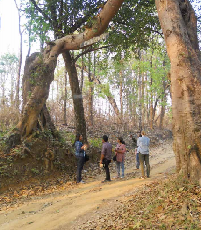Linking Adaptation and Mitigation through Community Forestry: Case Studies from Asia


Ban Huay Win, Nan Province, Thailand
This research aims to address the potential linkages between mitigation and adaptation in community forestry contexts. This case study highlights the work undertaken in Ban Huay Win, Nan Province, Thailand, from which data was gathered and compiled alongside findings from four other sites across Asia (Meru Betiri National Park, Indonesia; Dhanusa, Nepal; Da Loc Commune, Vietnam and Seima Protected Forest, Cambodia) to analysehow and why adaptation considerations must be integrated within forest-based mitigation efforts such as REDD+.
Methods
Participatory Rural Appraisal (PRA) methodologies facilitated the collection, presentation, and analysis of the data with rural community members.
Research questions that directed the focus group discussions and interviews generally addressed:
- What have been the physical changes in the local environment over the recent past?
- What have been the impacts of any such changes on local communities and their livelihoods?
- What are the sustainable livelihood assets possessed by the community, particularly linked to forests, which might contribute to adaptive capacity?
- How are community forestry management strategies contributing to adaptation and mitigation needs?
- How are forest management strategies, including mitigation initiatives, potentially adversely impacting the adaptive capacity of local communities?
Key Outcomes
The case studies provide important lessons on the role of community forestry in Asia in contributing to both climate change adaptation and mitigation needs. They provide glimpses into the various ways community forestry supports community resilience not only through the sustainable management of natural resources, but also through the enhancement of social and human capital. They also offer valuable lessons on community uses and management of forests in a variety of contexts and the complex interplay between local livelihoods and the physical environment. Finally, in addition to the positive contributions, the case studies highlight potential trade-offs between mitigation and adaptation objectives, and local livelihoods and development needs; recommendations are made on how to address these issues.
Partners
The research and publication of these case studies was funded by the Climate Knowledge Development Network (CDKN), REDD-net, Adaptation Knowledge Platform, and Raks Thai Foundation (CARE Thailand). The following organizations assisted the study: the Cambodia Rural Development Team (CRDT), CARE Vietnam, CARE Nepal, Hue University of Agriculture and Forestry Vietnam, Lembaga Alam Tropika Indonesia (LATIN), and Raks Thai Foundation (CARE Thailand).
(0) Comments
There is no content